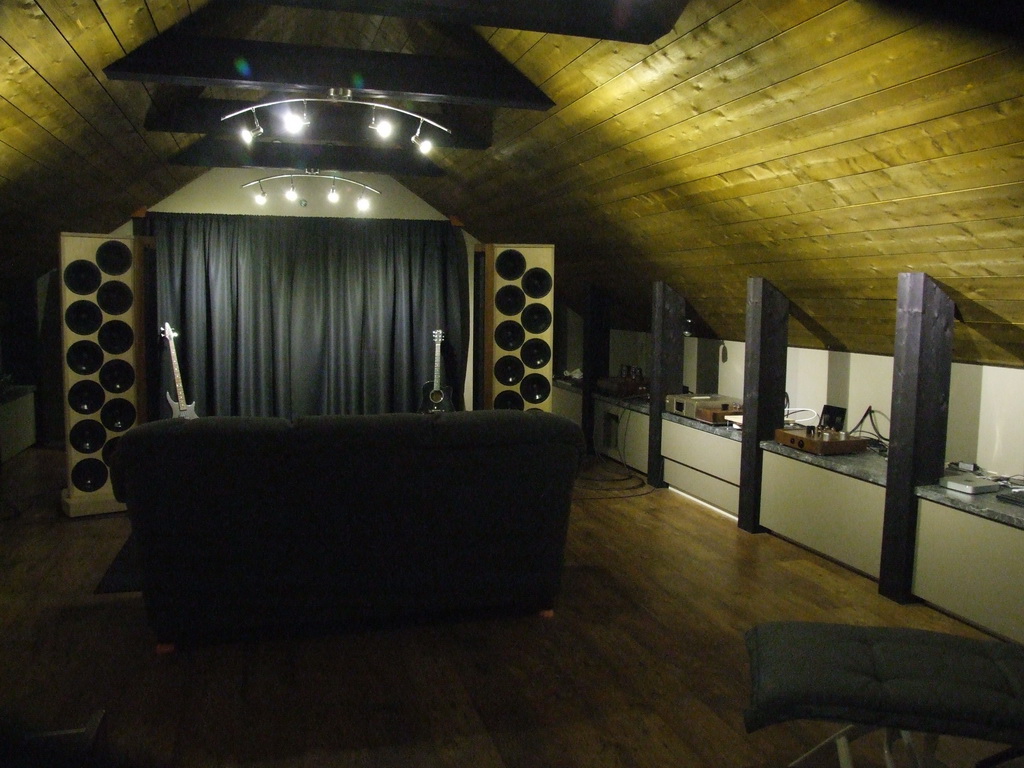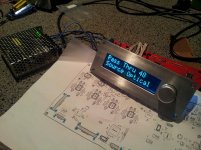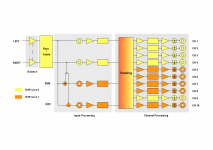You´ll be needing a big box!
Or maybe you plan to put the PSU's in a separate one?

It will go in the drawer under the Sony scd-777es
Had mine up and running for the first time tonight.
Bit of a hickup with the lcd wiring but all is well now.
Very beautiful!!
Hi to all,
did someone also observe that when choosing a setup with 192 Khz, the DSP Core 0 starts at nearly 80%, and in my case if I make a 3 way stereo crossover (BW, 18Db/ octave) the DSP Core 0 overloads! It shows 120% overload!
On the other side streaming a file with 192 Khz under this conditions works without dropouts or pops. Is this overload normal??
Regards
Sigi
did someone also observe that when choosing a setup with 192 Khz, the DSP Core 0 starts at nearly 80%, and in my case if I make a 3 way stereo crossover (BW, 18Db/ octave) the DSP Core 0 overloads! It shows 120% overload!
On the other side streaming a file with 192 Khz under this conditions works without dropouts or pops. Is this overload normal??
Regards
Sigi
Had mine up and running for the first time tonight.
Bit of a hickup with the lcd wiring but all is well now.
Hi,
wonderful display and build. Can you give us the type of display and a link where to get it?
Thanks in advance
Sigi
Thanks folks. Display is lcd, same one that jcga is using,
ART BIG LCD 2x16 With LED B L W KK HD44780 122x44mm ABC016002C41 DLW R | eBay
The knob will actuate 2 micro switches with a cam to control the volume, sort of a hacked up jog knob setup
ART BIG LCD 2x16 With LED B L W KK HD44780 122x44mm ABC016002C41 DLW R | eBay
The knob will actuate 2 micro switches with a cam to control the volume, sort of a hacked up jog knob setup
did someone also observe that when choosing a setup with 192 Khz, the DSP Core 0 starts at nearly 80%, and in my case if I make a 3 way stereo crossover (BW, 18Db/ octave) the DSP Core 0 overloads! It shows 120% overload!
On the other side streaming a file with 192 Khz under this conditions works without dropouts or pops. Is this overload normal??
Yes, I got similar. Core load high on just pass through and with any kind of X-over it overloads.
I had to resort to 96kHz setup.
If we are doing something wrong - someone please advise!
Yes, I initially thought that it was adding to the output clipping so brought it back down. I experimented just now and have it back at +5V this is helping, but would still be good for some more output.Have you tried boosting the nominal output level? In the menu, Settings -> Board Configuration (Najda must be connected). By default, output level is 1 Vrms, you can increase it up to 6 Vrms.
I'm running my negative gain in the 'pre-gain' for each channel under the channel processing tab (should this be done globally in the 'input processing'?)As Jean-Claude said, digital gain values are generally going to be negative. This is because the processing needs some headroom for EQs in particular, but also for cross-over filters that present a bit of overshoot. You can compensate further with analogue gains as explained above.
This will probably be useful for me. Earlier I was getting something strange on my mid-range channels - when looking at the monitor tab VU type meters I was getting the top red bar blinking for overload but the four or five bars below that are never illuminating. So I wasn't seeing any orange bars as a pre warning it just jumped straight into the red from about -12dB bar. This was when I was running -15dB Post-gain to try and stop the clipping. I just put it back to -2dB and it looks normal again (no clipping).The manual is coming, there's a paragraph on adjusting gains.
did someone also observe that when choosing a setup with 192 Khz, the DSP Core 0 starts at nearly 80%, and in my case if I make a 3 way stereo crossover (BW, 18Db/ octave) the DSP Core 0 overloads! It shows 120% overload!
On the other side streaming a file with 192 Khz under this conditions works without dropouts or pops. Is this overload normal??
192 kHz sampling frequency is quite power hungry. One thing you should look at is distributing the load among the DSP cores. If you have a doubt, please send me your nsf file.
Another thing that can help reducing load on core 0 is disabling Bass/Treble section.
5 Vrms output swing is quite a lot. You might want to send me your nsf file and I'll have a look at it.Yes, I initially thought that it was adding to the output clipping so brought it back down. I experimented just now and have it back at +5V this is helping, but would still be good for some more output.
No that should be alright.I'm running my negative gain in the 'pre-gain' for each channel under the channel processing tab (should this be done globally in the 'input processing'?)
That's as expected: once you're clipping (i.e. the ovf segment is turning on), then the VU-meters aren't displaying relevant information because truncation is taking place. If the ovf segment is turning on, then you must lower the corresponding gain.Earlier I was getting something strange on my mid-range channels - when looking at the monitor tab VU type meters I was getting the top red bar blinking for overload but the four or five bars below that are never illuminating. So I wasn't seeing any orange bars as a pre warning it just jumped straight into the red from about -12dB bar. This was when I was running -15dB Post-gain to try and stop the clipping. I just put it back to -2dB and it looks normal again (no clipping).
Hi,
I've been following this tread for some time now, and I'm almost ready to make the jump. I have a few comments about the Najda under control software.
I really like the new option about custom Biquad. It work ok, but I find it difficult to work with it since you can not from the software see the coefficients that you've enter. It is hard to see really what your doing. Plus there is no way to get you coefficients back once load in the card if you loose your text file. So, what I propose is to have a custom Biquad button that pop a new window with all the coefficients available. It would make adjustment more simple and easy.
Also the same way of doing thing could be done with the input and the output graph. This way you can check the progress of what your doing in real time.
Also could it be possible to add custom biquad in the crossover section too. I realize that it could be done in the PEQ section but in the case that you want a 8 order low pass and High pass, it will eat up a lot of biquad coefficients, and leave you only 1 or 2 for filtering.
Thank you for you great support and listening to all are CONSTRUCTIVE complains .
P.S
Id someone have a suggestion of a 8ch DAC that is a good match with the Najda
I've been following this tread for some time now, and I'm almost ready to make the jump. I have a few comments about the Najda under control software.
I really like the new option about custom Biquad. It work ok, but I find it difficult to work with it since you can not from the software see the coefficients that you've enter. It is hard to see really what your doing. Plus there is no way to get you coefficients back once load in the card if you loose your text file. So, what I propose is to have a custom Biquad button that pop a new window with all the coefficients available. It would make adjustment more simple and easy.
Also the same way of doing thing could be done with the input and the output graph. This way you can check the progress of what your doing in real time.
Also could it be possible to add custom biquad in the crossover section too. I realize that it could be done in the PEQ section but in the case that you want a 8 order low pass and High pass, it will eat up a lot of biquad coefficients, and leave you only 1 or 2 for filtering.
Thank you for you great support and listening to all are CONSTRUCTIVE complains .
P.S
Id someone have a suggestion of a 8ch DAC that is a good match with the Najda
192 kHz sampling frequency is quite power hungry. One thing you should look at is distributing the load among the DSP cores. If you have a doubt, please send me your nsf file.
Another thing that can help reducing load on core 0 is disabling Bass/Treble section.
Hi Nick,
Bass/Treble was already disabled! What would be the best distribution on core 0 with a stereo crossover ( 3 channels, BW 18 Db/ octave) ? At 192 Khz SR the load of core 0 is nearly 80% as pass through. Will it be possible to distribute the load with a 3 way crossover without running into overload? If not, what happens if I run it with 120% oberload?
Regards
Sigi
Bass/Treble was already disabled! What would be the best distribution on core 0 with a stereo crossover ( 3 channels, BW 18 Db/ octave) ? At 192 Khz SR the load of core 0 is nearly 80% as pass through. Will it be possible to distribute the load with a 3 way crossover without running into overload? If not, what happens if I run it with 120% oberload?
Hi Sigi,
You should not allow DSP load to go above 100%.
In pass-through, DSP load shouldn't be as high as 80%. Don't you have some EQs lying around that you forgot to turn off?
In any case, please send me on my email your intended nsf file otherwise I can't really help.
Best,
Nick
Added one eq for channel one and two, then it went to 101% on core 0.I just managed to create a 3-way 192khz 4/order first xo and 2/order second
xo, one eq for channel 3 and 4. 96% on core 0. With 96 khz it's no problem at all.
I just managed to create a 3-way 192khz 4/order first xo and 2/order second
xo, one eq for channel 3 and 4. 96% on core 0. With 96 khz it's no problem at all.
Great! Did you distribute the 6 channels in another way as the default? I had no success with the default order. Desactivated bass and treble, no EQ at all, but it keeped with overload at 120%. I had to add delay to bass and treble.
Could you send me your file to see how you managed it?
Best regards
Sigi
Yes, it's routed as default. 96% core0 74% core1. You have mail.Great! Did you distribute the 6 channels in another way as the default? I had no success with the default order. Desactivated bass and treble, no EQ at all, but it keeped with overload at 120%. I had to add delay to bass and treble.
Could you send me your file to see how you managed it?
Best regards
Sigi
Here's a diagram of the processing load distributed among the DSP cores. Can be helpful
View attachment 355365
Thanks, but when using spdif outputs you're a bit limited anyway.
On another matter. In post 1249 you posted a picture of the Wave io
connection. I have connected over the uf-l connectors but I'm getting blinks
from the dsp-overload led. I haven't listened to it yet but I suspect that it will
behave as it did for a few others. Did you try the uf.l connection ? And do you
think that you can find the time to make drawing of the connection. The
picture was a bit unclear.
- Home
- Source & Line
- Digital Line Level
- DSP Xover project (part 2)

